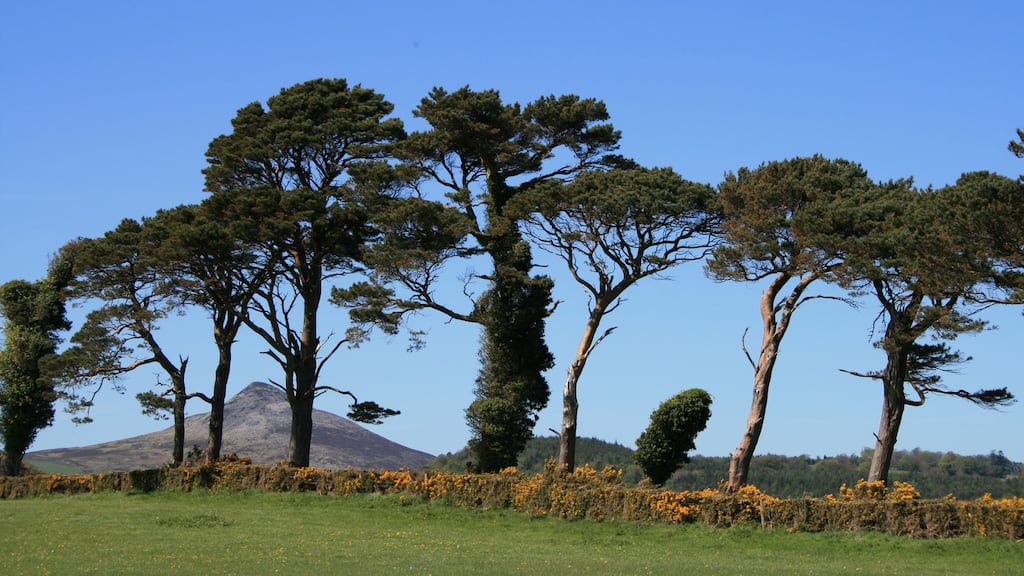Gannon’s Wood, a strip of mixed woodland in the grounds of Clonalis House, just outside Castlerea in Co Roscommon, is owned by the O’Conor family and part of the Suck Valley Way. Recently I walked the muddy, well-trampled path that winds through it, stopping to read the labels and descriptions attached to a selection of native trees.
In the middle of the woods is a majestic Scots pine, erect like a soldier, with its verdant crown reaching for the sun. It is a striking, handsome evergreen with an orange- and purple-tinged bark etched with time; as the years go by, it thickens up and becomes layered with woody, furrowed scales.
Scots pine is a tree that always impresses. I remember, back in 2006 or so, walking across the mountain blanket bogs of Kippure in Co Wicklow with Anthony McElheron, a wildlife ranger who had written a delightful book about the smallest of our native falcons, the merlin. Merlins lay their eggs in abandoned crow nests; they favour the strong upper branches of Scots pine, which can reach 30 metres. It makes for the ultimate nest with a view.
In the middle of this bare, undulating landscape was a stand of trees, but a single, majestic Scots pine stood out; it was in a different league to trees around it.
I’m not ready to let Bridget Jones go just yet. She has been a constant comfort to me and so many women I know
‘Irish teenagers are so innocent. Where I’m from we learn not to be naive’
Oesophageal cancer: ‘I was fine, there was nothing wrong with me’
Doireann Garrihy restores some celeb lustre to troubled 2FM with larky verve
Scots pine has an enormous distribution range across thousands of miles, from the Arctic Circle to North Africa and Siberia. In prehistoric times, mountainous and lowland areas across Ireland would have been covered by Scots pine forests.
A significant decline, which began in 2,500 BC, led to its disappearance by about 400 AD. It was assumed to have gone extinct, and in 1936, the naturalist Robert Lloyd Praeger wrote that its “complete disappearance” as a native tree was “the most notable event in the history of Irish trees”.
Since it grows across continents and survived in places like Scotland, why did it fail here? Scientists have suggested a few reasons: climate change, human activity, pathogens, effective competition from alder and displacement by the spread of blanket bog. Along with that is exploitation for timber, as unlike other trees, such as oak, Scots pine cannot be coppiced. If it is cut down, the rootstock will die.
By the 1600s, Scots pine from Scotland were imported and planted in large estates across the country to bring the tree back into Ireland. These trees have naturalised and spread, helped by a short-lived State-sponsored planting regime that favoured Scots pine as the main conifer species to plant in the 1930s.
Planting dwindled to almost nothing by the 1980s, replaced by other faster-growing and more commercially viable species such as Sitka spruce and lodgepole pine. Today, Scots pine make up just 1.2 per cent of forest area.
Until recently, it was assumed that all Scots pine now growing in Ireland are descendants of Scottish stock. But in 2016, Trinity College scientists discovered that a small stand of Scots pine in the limestone habitat of the Burren called Rockforest, just 10km from Corofin, did not go extinct after all but persisted to the present day.
Why this happened is not clear; it may have been that the remote location or the limestone pavement meant that this land was too difficult to convert to agricultural use, so the trees survived.
And so, native Scots pine, believed to have disappeared, were discovered in a remote corner of the west of Ireland. Is it fair to assume that these would stick out as genetically distinct from Scots pine found elsewhere in Ireland – those trees reintroduced from Scotland in the past few hundred years?
The answer, it seems, is no. In a paper published last month, scientists genetically described these reintroduced trees for the first time, and there appears to be no clear genetic difference between Rockforest Scots pine and reintroduced Scottish stock.
The study’s authors, Dr Jenni Roche from the National Parks and Wildlife Service and Dr Colin Kelleher of the Office Public Works’ National Botanic Gardens of Ireland, say that the Scottish trees here are so genetically similar to the Rockforest trees that they should be managed as native species.
Suppose this view is broadly accepted, and public money continues to be made available for native tree planting. In that case, it might take the pressure off Rockforest in Clare, a focal point for re-establishing this native tree, as growers collect thousands of pine seeds and nurse the young trees on, ready to be planted as part of native woodland initiatives. Last year, more than 2,000 of these trees were planted in Glenveagh National Park in Co Donegal.
The implications of Dr Roche and Dr Kelleher’s work are that the reintroduction of Scots pine using Scottish trees has succeeded; it behaves as a native species and should be treated as such. But with the complicated story of Scots pine in Ireland, do not rule out further twists and turns.
The Woodland Festival in Clonalis Estate in Castlerea, with 700 acres of farmland and woodland, takes place this August. See woodlandfestival.ie for more information
Sign up for push alerts and have the best news, analysis and comment delivered directly to your phone
Find The Irish Times on WhatsApp and stay up to date
Our In The News podcast is now published daily – Find the latest episode here













